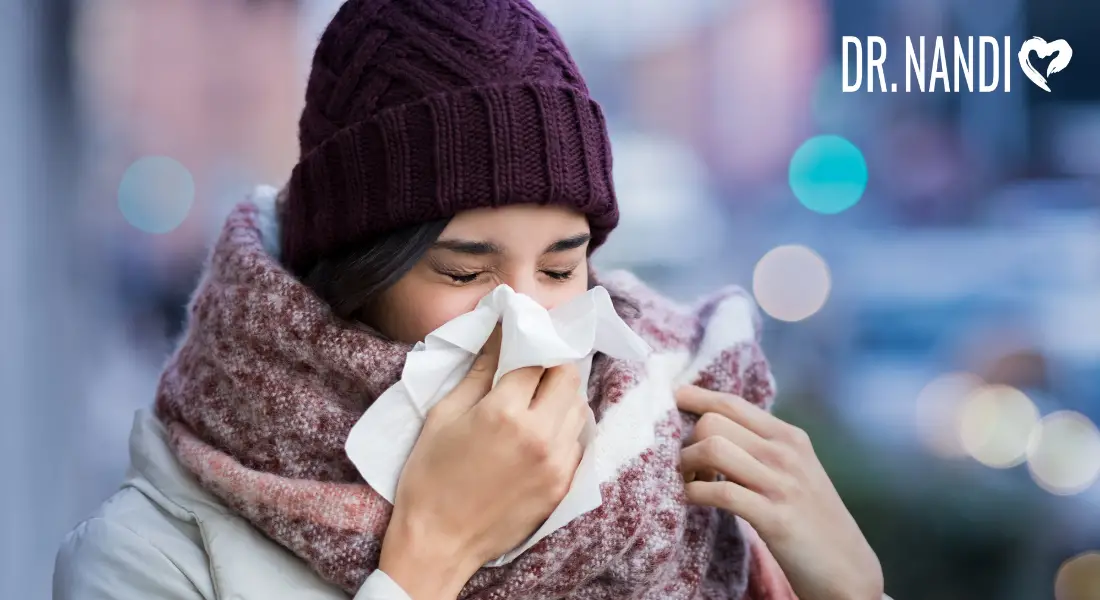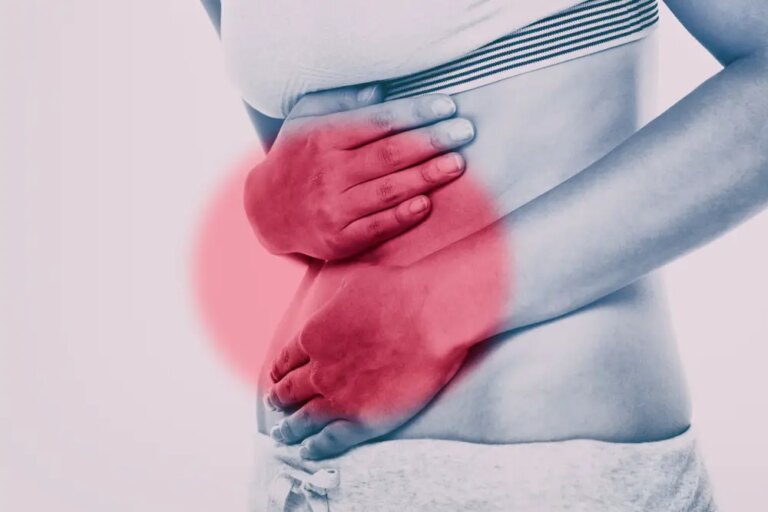Winter is often dreaded for its cold bitter temperatures while being well known and tied to being the season for sniffly runny noses, and coming down with viruses that leave us feeling under the weather and bedridden. But some common conditions become more prominent during the winter months as well.
Most Common Wintertime Health Problems
As temperatures drop in the winter, weather-related health problems begin to rise. Well-known winter ailments like cold and flu are easily spread. Dry skin, joint pain, asthma, and other notable weather-related health risks and ailments also begin to rise during the colder months.
Cold & Flu
Colds in the winter are prevalent. The common cold makes itself known through minor, but irritating congestion, sore throat, and sneezing. Both the cold and flu bring similar symptoms, but with the flu, it’s likely to result in a fever and body aches. Commonly known as the flu, influenza is one of the most contagious respiratory illnesses caused by influenza A or B viruses. The flu spreads through the upper and lower respiratory tract and can lead to life-threatening complications.
Prevention: It’s important to know that antibiotics are typically only administered for bacterial infections, as they are unable to treat the common cold since they are viral. To reduce your risk of exposure to viruses such as the common cold and the flu, it is recommended to frequently wash your hands, especially after making contact with someone else’s hands. Staying hydrated, eating a balanced diet, exercising, and getting plenty of rest is helpful for prevention. Getting the flu shot is very important in prevention.
Dry Skin
Cold temperatures and low humidity are known to draw moisture away from the skin. Winter winds and dry indoor heat can even make dry skin even worse. Dry skin, for many, can easily be remedied with consistent moisturizing. But dry skin can sometimes cause its own set of problems, including cracked skin that can not only be painful but can lead to infection if not treated properly. Skin conditions like eczema or psoriasis can also flare during these conditions.
Prevention: Choose a moisturizer that seals in moisture, and double up with an additional layer of moisturizer on top during these cold winter months. Avoid long hot showers as they can strip your skin from their important oils. If you notice that over the counter products aren’t working, seek out a dermatologist who may be able to offer medications to support your specific skin conditions and concerns.
Joint Pain
Scientific evidence has shown that cold, damp days assist in flare-ups to those who suffer from arthritis. Changes in barometric pressure can also worsen knee pain, as well as changes in joint fluid thickness. These nagging aches and pains become even more common when suffering from a common cold or the flu.
Prevention: Diet plays a large role in aiding in the symptoms suffered from joint pain. Foods with Omega-3 fatty acids like salmon and nuts are options that help lessen inflammation. Vitamin K, found in leafy greens such as spinach, kale, and cabbage helps to support strong bones and cartilage. Vitamin C found in oranges, red peppers, and grapefruit help stop cartilage loss that can be brought on from arthritis. Please consider swapping refined grains for whole grains. Supplements with vitamin D as well as glucosamine sulfate and chondroitin can help increase lubrication as well as nourishing your cartilage. But most importantly, stay moving! While you may feel less inclined to work out, exercise keeps your joints lubricated helping to prevent joint pain.
Seasonal Affective Disorder (SAD)
Seasonal Affective Disorder (SAD) affects many folks during the winter months. People who suffer from this disorder experience their symptoms at particular times of the year. The condition is recognized by the onset of depression that can come about during the early winter months typically when exposure to sunlight lessons. During the winter you may experience trouble getting up, or suffering from bouts of fatigue during your day. Mood swings are likely, and you may even feel compelled to overeat even without experiencing depression. It is believed that the reduced sunlight during this time disrupts your bodies internal clock which leads to a drop in chemicals like serotonin and melatonin.
Prevention: Sometimes this condition will be treated with light therapy, called phototherapy. This produces effects comparative to natural light that allow chemicals in your brain to trigger regulating your mood. Lifestyle changes like exercising regularly, taking time to get outside, getting plenty of sleep, and relaxation.
Asthma
Asthma is easily triggered by cold, dry air, making winter a nightmare if you experience difficulty breathing. Winter’s dry and windy conditions allow for mold and pollen to swirl about making asthma sufferers more susceptible to attacks.
Prevention: To make winter easier on your asthma, use preventative measures to steer clear of common colds or the flu which ultimately will lead to your asthma flaring up. Try to avoid sitting near fireplaces, as burning wood can irritate your lungs like burning tobacco. Replace filters in home heating systems to avoid dust and debris being dispersed in your house. Try exercising indoors to avoid asthma flare-ups during the colder months. And when you are working out, warming up beforehand allows people with asthma to recover faster while having a greater lung function.
Frostbite
When you think of people catching frostbite, you might picture brave weather-beaten hikers deep on a mountain range. Or maybe they are out on an epic journey, climbing Mount Everest in the dead of winter. Normally, people don’t associate frostbite with anything other than these kinds of scenarios. Frostbite, however, can be a serious issue, worldwide, including the United States.
Prevention: For now, let us focus on the many different ways that frostbite can be prevented. If you are out in the frigid air, then these tips might be able to prevent you from catching frostbite and even potentially save your life!
- Avoid Going Outside, If Possible
If you live in an area where the temperature frequently drops down close to 0° Fahrenheit during the winter, then it is typically best to not go outside during the winter unless you have a good reason too. If you absolutely have to go outside, make sure that you limit your time outside so that you’re not spending too much time in the cold. And be sure to always wear proper layers of clothing!
- Make Sure You Dress Properly
You can be outside for longer periods of time if you are properly dressed. This means wearing multiple layers of clothes that each serve a purpose. It’s okay to wear long thermal underwear when you’re going to be going outside. Long sleeve shirts and jackets are fine to wear too. It’s also important to make sure that your outer layers have the ability to stop the wind and to be waterproof. A high-quality windbreaker can do this. Don’t forget to wear gloves, scarves and beanies as well. Cover as much as your body as you can.
- Keep Your Clothes Dry
In the event where you get your clothes wet, it is vital that you remove them and get changed and warm immediately. If you cannot, then you must find a way to prevent the wet clothes from touching your skin. If you’re going to be outside for a long time, make sure that you have access to dry clothes.
- Do Not Drink Alcohol When In The Cold
Alcohol does not increase your body temperature when it is cold. It will not warm you up, despite what people say. In fact, alcohol does the exact opposite of this, as it impairs the body’s ability to properly keep a stable temperature in cold weather. Smoking has a similar effect.
- Pay Attention To Your Body
If you are worried that you are getting frostbite, or that your body is becoming too cold, then the best thing you can do is put yourself inside a warm area, away from the frigid air. If you are concerned that you have frostbite then you should reach out for medical help immediately. If you have blistering or loss of feeling then a medical professional should look at you as soon as possible.
Opening Your Heart To The Homeless Population & Reducing Their Risk Of Winter Ailments
There are many who are not fortunate enough to have a warm home this winter. There are over 570,000 homeless people in the US and approximately 18,000 are here in my hometown of Detroit. Ask Dr. Nandi Charities is on a mission to provide warmth to Detroiters in need by collecting thousands of winter coats for donation to several local charities.
This will be Dr. Nandi’s 6th Annual Coat Drive and we are so proud to say we have collected and given away over 20,000 coats. We want this to be the biggest and WARMEST year for our community.
We have made it easier than ever to support Detroiters in need no matter where you are in the world >> just click here to select and purchase a coat and it will go directly to a Detroiter in need <<
We are always able to help ourselves stay warm and healthy during the winter. This year, let’s try to help those that cannot find help. Hopefully, by doing so we can combat winter ailments and make the world a warmer place.























